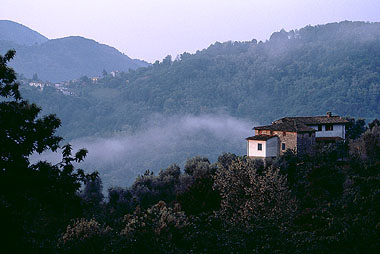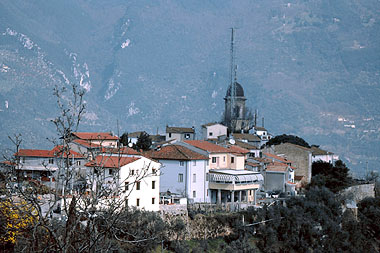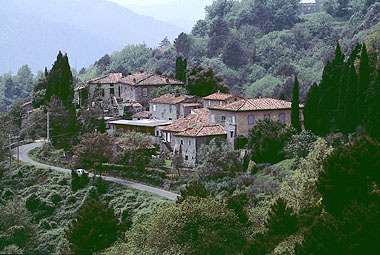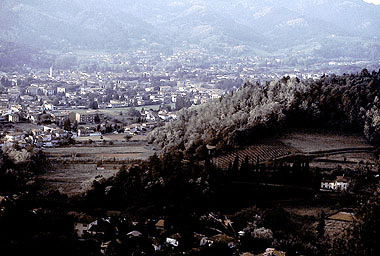The territory of Camaiore

Information
District/Location:
Camaiore
District:
Versilia

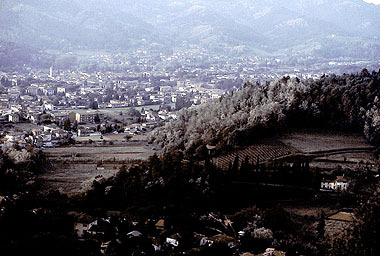
The Camaiore region is rich in natural and historical attractions. The mountains on one side and the plain on the other contain villages, churches and abbeys that are witnesses to its long history. The area is covered by the scattered remains of fortified villages and feudal castles built between the Xth and the XIVth centuries. Indeed, Camaiore's strategic position attracted the interest of Lucca, Pisa and Florence. Since the Middle Ages the government of Lucca fought and eventually defeated the Cattani or Cattanei, lords of Versilia, in the intent of gaining access to the sea; later it successfully defended the new colony of Camaiore and its territory against the Pisans and the Florentines.
The traces of ancient walls, rocche and towers are hidden amidst the vegetation in magnificent surroundings, on the austere background of the Apuan Alps and are not always easy to reach.
The traces of ancient walls, rocche and towers are hidden amidst the vegetation in magnificent surroundings, on the austere background of the Apuan Alps and are not always easy to reach.
Castle of Montebello
Montebello is a small pretty village gathered around its church at the foot of Mount Gabberi. The remains of a fortified place, mentioned since 1192 and known as 'il Castellaccio' are still visible to the north of the present day village. Among the shrubs we can make out the base of a round tower and portions of the irregular walls that followed the conformation of the ground. The castle of Montebello fell under the control of Lucca in the middle of the XIIIth century. The Archaeological Group of Camaiore has explored the area in 1984, bringing to light potsherds referable to the XIIth-XIVth centuries that are now kept at the Municipal Archaeological Museum.
Castle of Greppolungo
The village of Greppolungo lies to the north-west of Camaiore, on a rocky ledge just above 330 m. a. s. l.. From here we have a great view on the Camaiore valley, squeezed in between the peaks of the Apuan Alps and the seashore, with villages and villas inserted along its slopes.
The area where this small village now stands used to be fortified in feudal times and fell under the control of Lucca in the XIIIth century. Only portions of walls to the south of the village and a grindstone hewn out of the rock, hidden among terraced olive groves, remain of the castle of Greppolungo, mentioned as early as 1219.
Castle of Montecastrese
On the hill of Montecastrese, also known as Monte La Torre, we find the remains of the last castle to fall under the arms of Lucca, in 1226. Archaeological finds from the Roman Age, two funerary inscriptions and coins of the Republican Age, suggest that the castle was built upon a previous settlement. The place-name comes, indeed, from the Latin word castrum meaning military camp or fort.
Inside a thicket we can see several stretches of walls along an irregular perimeter that follows the uneven ground. Inside this perimeter are the remains of no less than 100 dwellings, side by side or arranged according to the terraces of the steep slope. On a rise are the remains of a square 5,5 x 5,5 m. tower. Further south are traces of another tower, mentioned more than once in documents from the archives.
In 1980 the Archaeological Group of Camaiore promoted a study on the area, but it was impossible to draw a map of the site because of the dense vegetation.
Castle of La Penna
The remains of the castle can be found north-east of Camaiore, in the southern part of the territory of Casoli, precisely at the top of mount La Penna. Mentioned since 1310, the fortified village had no cassero and probably consisted only of humble workers' dwellings. The remains of some twenty houses, portions of walls and a grindstone hewn out of the rock have actually been found. The Archaeological Group of Camaiore explored the area in 1992, bringing to light potsherds referable to the XIIth-XIVth centuries, now kept at the local Municipal Archaeological Museum; some scholars maintain, however, that the area was already settled in the Neolithic or Aeneolithic Ages.
Castle of Peralla
The ancient castle of Peralla was situated at about 300 m. a. s. l. in the territory of Pieve di Camaiore, close to the last rises of mount Pedone. Mentioned since 1208, the fortified village is now documented by the ruins of a tower and of walls, north-east of the modern holiday village.
Castle of Pedona
Pedona is a small village on a very steep hill, from which we have a wonderful view of the entire Camaiore valley. A "castrum, qui dicitur Pedoni" is mentioned since 1099, but it was only in the first half of the XIIth century that the castle fell into the hands of the government of Lucca and became part of the Republic's defensive system.
Probably the ancient fortified village occupied the same place as the modern village, though nowadays only short stretches of the walls are to be seen. Archive sources speak of a church consecrated to S. Jacopo within the castle; this probably stood where the modern church, named after the same saint, now stands.
XVIth century sources, moreover, mention two towers one of which, triangular, was destroyed and rebuilt several times, while the other, round, was at the time already in a state of abandon.
Castle of Albiano
The site of the castle of Albiano, mentioned since 1183, is now occupied by a place named Castello that is part of the village of S. Maria di Albiano. An approximately 5 metre long wall curtain is the only evidence of ancient fortifications, near the small stone village now marked by the presence of the beautiful XVIth century villa belonging to Mr. Trevilian.
Castle of Gombitelli
The village of Gombitelli, a few kilometres from Castello, is in a wonderful position. It's castle, mentioned in documents of the year 1029, was a fortified village; today we can see here the rests of dwellings and of two towers, one square and the other irregularly shaped, in a commanding position. These rests are scattered in the wood above the village and are difficult to find since they are not marked.
Castle of Fibbialla
The ancient castle probably stood where today we find the village of Fibbialla. Built between February and July 1123, it was destroyed in 1313 by Uguccione della Faggiola, Lord of Pisa. Today nothing remains of it.
Castle of Orbicciano
In a document dated 1183 the men of the castles of Albiano and Orbicciano swore their loyalty to the government of Lucca. It is not possible to indicate where the castle used to stand. The place-name Orbicciano has however been retained by the present day village.
Montebello is a small pretty village gathered around its church at the foot of Mount Gabberi. The remains of a fortified place, mentioned since 1192 and known as 'il Castellaccio' are still visible to the north of the present day village. Among the shrubs we can make out the base of a round tower and portions of the irregular walls that followed the conformation of the ground. The castle of Montebello fell under the control of Lucca in the middle of the XIIIth century. The Archaeological Group of Camaiore has explored the area in 1984, bringing to light potsherds referable to the XIIth-XIVth centuries that are now kept at the Municipal Archaeological Museum.
Castle of Greppolungo
The village of Greppolungo lies to the north-west of Camaiore, on a rocky ledge just above 330 m. a. s. l.. From here we have a great view on the Camaiore valley, squeezed in between the peaks of the Apuan Alps and the seashore, with villages and villas inserted along its slopes.
The area where this small village now stands used to be fortified in feudal times and fell under the control of Lucca in the XIIIth century. Only portions of walls to the south of the village and a grindstone hewn out of the rock, hidden among terraced olive groves, remain of the castle of Greppolungo, mentioned as early as 1219.
Castle of Montecastrese
On the hill of Montecastrese, also known as Monte La Torre, we find the remains of the last castle to fall under the arms of Lucca, in 1226. Archaeological finds from the Roman Age, two funerary inscriptions and coins of the Republican Age, suggest that the castle was built upon a previous settlement. The place-name comes, indeed, from the Latin word castrum meaning military camp or fort.
Inside a thicket we can see several stretches of walls along an irregular perimeter that follows the uneven ground. Inside this perimeter are the remains of no less than 100 dwellings, side by side or arranged according to the terraces of the steep slope. On a rise are the remains of a square 5,5 x 5,5 m. tower. Further south are traces of another tower, mentioned more than once in documents from the archives.
In 1980 the Archaeological Group of Camaiore promoted a study on the area, but it was impossible to draw a map of the site because of the dense vegetation.
Castle of La Penna
The remains of the castle can be found north-east of Camaiore, in the southern part of the territory of Casoli, precisely at the top of mount La Penna. Mentioned since 1310, the fortified village had no cassero and probably consisted only of humble workers' dwellings. The remains of some twenty houses, portions of walls and a grindstone hewn out of the rock have actually been found. The Archaeological Group of Camaiore explored the area in 1992, bringing to light potsherds referable to the XIIth-XIVth centuries, now kept at the local Municipal Archaeological Museum; some scholars maintain, however, that the area was already settled in the Neolithic or Aeneolithic Ages.
Castle of Peralla
The ancient castle of Peralla was situated at about 300 m. a. s. l. in the territory of Pieve di Camaiore, close to the last rises of mount Pedone. Mentioned since 1208, the fortified village is now documented by the ruins of a tower and of walls, north-east of the modern holiday village.
Castle of Pedona
Pedona is a small village on a very steep hill, from which we have a wonderful view of the entire Camaiore valley. A "castrum, qui dicitur Pedoni" is mentioned since 1099, but it was only in the first half of the XIIth century that the castle fell into the hands of the government of Lucca and became part of the Republic's defensive system.
Probably the ancient fortified village occupied the same place as the modern village, though nowadays only short stretches of the walls are to be seen. Archive sources speak of a church consecrated to S. Jacopo within the castle; this probably stood where the modern church, named after the same saint, now stands.
XVIth century sources, moreover, mention two towers one of which, triangular, was destroyed and rebuilt several times, while the other, round, was at the time already in a state of abandon.
Castle of Albiano
The site of the castle of Albiano, mentioned since 1183, is now occupied by a place named Castello that is part of the village of S. Maria di Albiano. An approximately 5 metre long wall curtain is the only evidence of ancient fortifications, near the small stone village now marked by the presence of the beautiful XVIth century villa belonging to Mr. Trevilian.
Castle of Gombitelli
The village of Gombitelli, a few kilometres from Castello, is in a wonderful position. It's castle, mentioned in documents of the year 1029, was a fortified village; today we can see here the rests of dwellings and of two towers, one square and the other irregularly shaped, in a commanding position. These rests are scattered in the wood above the village and are difficult to find since they are not marked.
Castle of Fibbialla
The ancient castle probably stood where today we find the village of Fibbialla. Built between February and July 1123, it was destroyed in 1313 by Uguccione della Faggiola, Lord of Pisa. Today nothing remains of it.
Castle of Orbicciano
In a document dated 1183 the men of the castles of Albiano and Orbicciano swore their loyalty to the government of Lucca. It is not possible to indicate where the castle used to stand. The place-name Orbicciano has however been retained by the present day village.
- GRUPPO ARCHEOLOGICO CAMAIORE, I castelli feudali del territorio di Camaiore, 1993
- SANTINIV., Commentari storici della Versilia, Pacini Editore, Pisa 1992
- RINUCCINI G.B., Di Camajore come città della Versilia e sue adiacenze, Firenze 1858 (ristampa Arnaldo Forni Editore, 1981)
- BELLATO F., Camaiore e dintorni (a cura del Cumune di Camaiore), 1999
Scopri altre attrazioni vicino a The territory of Camaiore
See allYou may also like..
See allFind more
0








